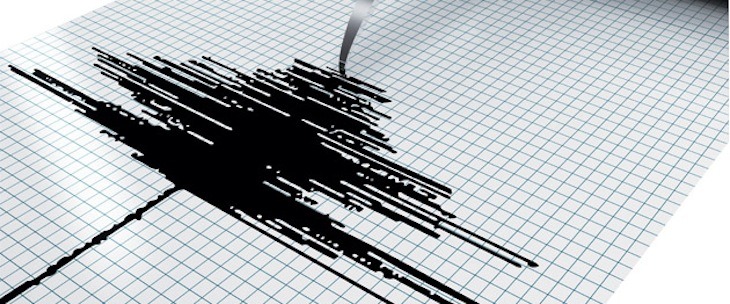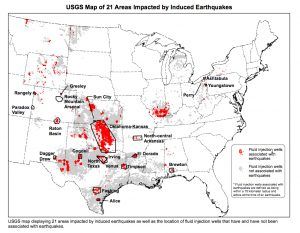USGS: Increased earthquake activity tied to wastewater injection from shale play
by June 26, 2017 3:13 pm 669 views

The increasing number of earthquakes in the U.S. east of the Rocky Mountains has coincided with the spike in production by energy companies that use underground wastewater injection to extract oil and gas from shale play formations, according to a new report by the U.S. Geological Survey (USGS).
The USGS has issued an updated 2017 forecast for the central and eastern U.S. showing that seismic rates are still significantly elevated compared with pre-2009 levels but lower than their peak in 2015. This forecast, which looks at five focus areas that includes Arkansas’ Fayetteville Shale play, attempts to estimate the chance of damage caused by earthquakes in the region of interest.
A year ago, the 2016 USGS forecasted indicated high seismic hazard, or greater than 1% probability of potentially damaging ground shaking in one-year, in Oklahoma-Kansas, the Raton Basin near the Colorado-New Mexico border, north Texas, north Arkansas, and the New Madrid fault zone near the Arkansas-Missouri state line. The 2016 report largely focused on increased seismic activity in Oklahoma, where all of the 21 magnitude four and five earthquakes occurred.
“Several observations of damaging ground shaking levels were also recorded in the highest hazard region of Oklahoma,” the report concludes.
The USGS report also notes there were no earthquakes higher than 2.7 magnitude that occurred in the north Arkansas and north Texas focus areas. The USGS’ notes that the 2017 forecasted seismic rates are lower in regions of induced activity due to lower rates of earthquakes in 2016 compared to 2015.
“(That) may be related to decreased wastewater injection, caused by regulatory actions or by a decrease in unconventional oil and gas production,” the USGS report states. “Nevertheless, the 2017 forecasted hazard is still significantly elevated in Oklahoma compared to the hazard calculated from seismicity before 2009.”
According to an analysis of the USGS report by the U.S. Department of Energy, more earthquakes in the key focus areas have coincided with the spike in oil and natural gas production from shale formations. Seismic events caused by human activity – also known as induced seismicity – are most often caused by the underground injection of wastewater produced during the oil and natural gas extraction process.

Before 2009, Oklahoma might have experienced one to two low-magnitude earthquakes per year. Since 2014, Oklahoma has experienced one to two low-magnitude earthquakes per day, with a few instances of higher magnitude earthquakes between 5 and 6 that caused some damage.
In addition to the increased use of wastewater injection related to oil and natural gas production in the region, the geologic conditions in central Oklahoma are conducive to triggering seismic activity, the EIA states. The rock underlying the formations where disposal water is being injected in the region has existing faults that are susceptible to the changing stresses caused by fluid injection.
“Without these geologic conditions, induced seismicity would be much less common. For example, induced seismicity in the Bakken region of North Dakota and Montana is relatively rare,” the EIA notes.
In light of the USGS report, the Oklahoma Corporate Commission in February issued a directive limiting the growth in future waste disposal rates into the area known as the Arbuckle formation.
“The data from the Oklahoma Geological Survey shows the earthquake rate has been dropping since we issued various directives reducing the then-current volume within the AOI,” said Tim Baker, director of the OCC’s oil and gas division. “The continued drop in earthquakes, as well as new data and input from the Oklahoma Geological Survey have caused a change in our orientation from focusing on current disposal volumes within the AOI to looking ahead to try and ensure there isn’t a sudden, surprise jump in those disposal volumes.”
Oklahoma has also been careful to note that the increased activity is not caused by hydraulic fracturing, or fracking, the controversial advance technology used to enhance the flow of energy from a well after drilling is complete. Wastewater injection is an entirely different process that’s used for disposing of waste fluids from oil and gas injection, which the Environment Protection Agency classifies under six categories.
At the annual EIA Energy Conference to be held Monday and Tuesday in Washington, D.C., panelist will discuss induced seismicity and the challenges and opportunities related to managing wastewater produced from oil and natural gas production.
